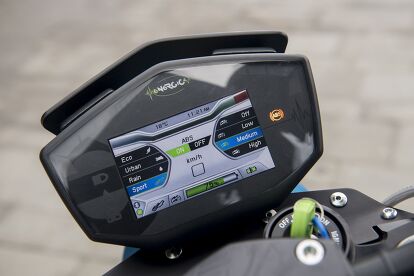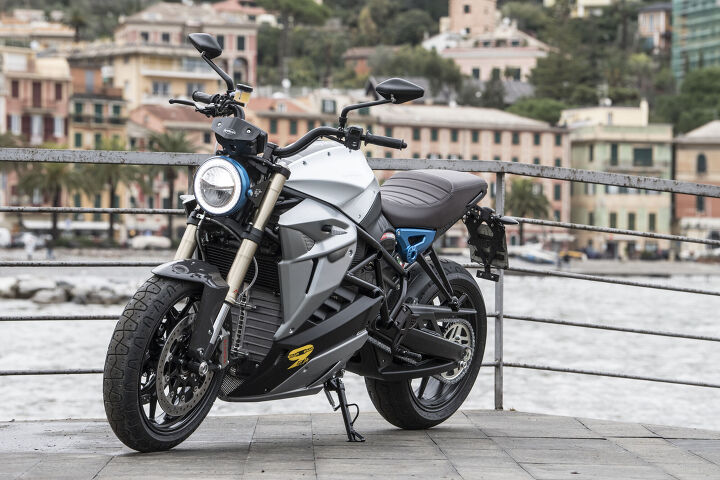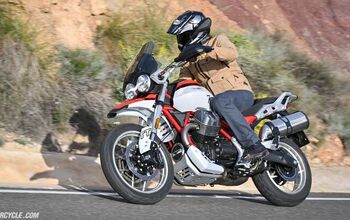2018 Energica Eva EsseEsse9 First Ride Review
The EV value proposition keeps improving
Energica made e-bike waves in 2013 when it let us ride the prototype of its Ego electric superbike that reached production in 2014, the year we tested a production version of the Ego. Boasting 136 hp and 144 lb-ft. of torque with a claimed 150-mph top speed, the Italian-designed Ego was fast and thrilling, to be sure. But its claimed 584-lb weight made it really heavy for a superbike, and its $34,000 MSRP destined it only for spots in the well-stocked garages of well-heeled enthusiasts. It fitted into a niche within a niche.
2018 Energica Eva EsseEsse9
| Engine | 19.0/20 |
| Suspension/Handling | 12.0/15 |
| Transmission/Clutch | 10/10 |
| Brakes | 9.5/10 |
| Instruments/Controls | 5.0/5 |
| Ergonomics/Comfort | 9.5/10 |
| Appearance/Quality | 9.0/10 |
| Desirability | 9.0/10 |
| Value | 6.5/10 |
| Overall Score | 89.5/100 |
Then came Energica’s Eva, which took the Ego’s platform and made it into a standard-ish naked sportybike that was more usable in most street conditions. Former editor Tom Roderick tested the Eva in 2016 and came away with many favorable impressions, but he lamented its $34,500 price and the fact that its motor offered less power than the Ego’s, at 107 hp (80 kw) and 133 lb-ft (180 Nm) of torque, while retailing for the same price. For 2018, the Eva 80 will be joined by the Eva 107, which features the Ego’s full-power.
Now comes the new EsseEsse9, which takes the Eva into a more traditional angle. Instead of an insectoid face with dual LED headlights, the EsseEsse9 is fitted with a lovely round LED headlamp ringed by an LED running light, impressively packaged inside a bucket made from billet aluminum with CNC-machined detailing. The milled bucket is accented by a blue hue, as are the aluminum seat supports that are reminiscent of those on BMW’s R-nineT. A pleated brown leather seat, which is less dished than the Eva’s black one, adds panache to the EsseEsse9 package, as does redesigned body panels. The handlebar is slightly wider and taller than the Eva’s, while the footpegs are placed forward a skosh.
Fun Fact: The EsseEsse9 takes its name from Via Emilia (SS9), an ancient Italian road built in 187 BC to connect Rimini to Piacenza, along Italy’s Motor Valley where Energicas, Ferraris and Lamborghinis are manufactured.
Most importantly for the sales viability of Energica are significant price reductions for 2018. The Eva will now retail for $23,400, the same price as the new EsseEsse9. The 2018 Ego has an MSRP of $24,900. Federal and state incentives can reduce the price even further.
Still a bit pricey, yes, but not for an exclusive Italian motorcycle with high-level componentry combined with leading-edge charging abilities. Energica offers the only electric motorcycles in the world with onboard DC fast-charge technology based on CCS (Combined Charging System) Combo, which said to be able to bring its 11.7-kWh lithium-polymer battery pack from zero to 85% in just 20 minutes. If no DC fast chargers (Level 3, 20 kw) are available, the battery can also be charged via Level 2 (6 kw) and Level 1 (1 kw) household currents.
We got the first crack at the EsseEsse9 earlier this week when I met with Energica’s U.S. reps at Mission Motorsports in Irvine, California, the latest dealer added to the brand’s American portfolio, along with locations in San Francisco and Santa Monica. Next up for general manager Stefano Benatti is to woo a dealer in Texas which understands the high-performance tie-in with Energica becoming the sole supplier in MotoGP’s upcoming FIM MotoE World Cup series in 2019, including the round in Austin at the Circuit Of The Americas.
Interview with Energica’s U.S. General Manager Stefano Benatti
The Eva EsseEsse9 feels agreeable when throwing a leg over its reasonably low 30.9-inch seat height, and its tubular handlebar is a modest stretch that puts a rider in a slightly forward lean. Footpegs are milled aluminum without rubber inserts because there is an absence of vibration from the electric motor as compared to a petrol-powered ICE bike. Coincidentally, ergonomics feel remarkably similar to the Yamaha XSR700 I rode in on. Ironically, both use Pirelli Phantom tires.
A 4.3-inch color TFT screen provides a host of info, including the settings for power delivery (Urban, Eco, Rain, Sport), four levels of regenerative braking, and battery range. A USB outlet is standard, and smartphones can be paired to the MYEnergica app that identifies the location of the nearest charging stations and types.
Riding off couldn’t be easier, as there is no clutch or gearbox to meddle with – it’s a scooter-like twist-and-go operation. Although the EsseEsse9 doesn’t have the power of the Ego, there is nothing humble about the output from its permanent magnet AC (PMAC) oil-cooled motor. Its claimed 133 lb-ft torque peak at its motor shaft positively humiliates the rear-wheel output of even the 1301cc engine in KTM’s muscular Super Duke R, at 95.7 lb-ft. The EsseEsse9 quickly reaches triple-digit speeds but is electronically limited to a 125 mph.
The sluggish steering we noted when testing the Ego is somewhat ameliorated by the EsseEsse9’s taller and wider handlebar, allowing quicker turn-in responses. Still, there’s no denying the bike’s considerable 580-pound (claimed) weight and longish 58.8-inch wheelbase. Initiating quick turns requires a deliberate shove on the bars, so don’t think of it as an electric-powered SV650 or anything of its ilk. It’s more like an Aprilia Tuono with a slightly underinflated front tire.
Regardless, it was enjoyable throwing the Energica into the few curves along our ride route, settling in nicely on its suspension when leaned over. I felt no need to tweak the settings on the fully adjustable Marzocchi fork, which provided exemplary action, but I would’ve added a click or two more rebound damping on the linkageless Bitubo shock if I had more time with it.
Slowing the EsseEsse9 is ably handled by a set of four-piston Brembo calipers and massive 330mm rotors up front, aided by switchable Bosch eABS. They offer a firm lever feel and precise control. It was fun to mess with the regen-braking settings to feel the vast distinctions between them. But no matter which was selected, the “throttle” response remained entirely predictable and intuitive. Engericas have a perfectly tuned neutral-throttle area between the closed- and open-throttle points that allows the bike to coast without adding engine/motor braking, avoiding any disturbing lurching. It feels like a well-tuned motorcycle rather than just a well-tuned e-bike.
Range is always an issue with any electric vehicle, but Energica says the EsseEsse9 can churn out about 125 miles when it’s set to its ECO mode and isn’t flogged down the highway for miles on end. Realistically, its 11.7kWh battery range is closer to 100 miles, and it’ll drop further with high-speed travel.
Energica’s batteries are housed in a splendid-looking aluminum case with finning and through-holes to help dissipate heat that would otherwise shorten the life cycle of the battery set. Concerns about battery life should allayed by Energica’s 31,000-mile warranty on it, and Benatti notes the company hasn’t had a battery failure in seven years of operation. The bike itself has a three-year warranty.
Although still hampered by limited ranges and high costs, electric motorcycles are experiencing improved value equations. Hundreds of charging stations are added each year, and I was surprised to note the relatively large number of the high-flow DC/CCS stations located in California. And individual communities continue to invest in charging infrastructure. For example, Santa Monica intends to have 1,000 chargers by 2025, up from less than 100 today. And Energica continues to expand its footprint, now having locations in the UK, Netherlands, Norway, Sweden, France, Germany, Switzerland, Spain, Portugal, Israel, and Italy.
Although my time on the bike was brief – too short to accurately gauge range and the other intangibles of living with a motorbike – I can say with confidence the EsseEsse9 is my favorite electric streetbike. It has more than enough power, a trustworthy chassis, and confident but not over-the-top styling. It makes a Zero SR feel cheap in comparison, and even with Zero’s Charge Tank, it can’t match the quick-charge abilities of the Energicas. More info can be found on EnergicaMotor.com
2018 Energica Eva EsseEsse9
+ Highs
- Attractive style at a lower price
- Plenty of power
- High-end componentry
– Sighs
- Energy density
- Impractical for longer trips
- Still pricey
Related Reading
2016 Zero DSR First Ride Review
Victory Isle of Man TT Zero Racebike Test
Living with a Zero SR
2016 Victory Empulse TT First Ride Review
Harley-Davidson LiveWire First Ride
2013 Brammo Empulse R vs. Zero S ZF11.4
2018 Energica Eva Esseesse9 Specifications | |
|---|---|
| Colour | Lunar White – Shocking Blue – Metal Black |
| Motor | Permanent Magnet Ac, Oil Cooled |
| Horsepower | 109 hp (claimed) |
| Max Speed | Limited At 200 Km/H – 125 Mph |
| Torque | 79.7 lb-ft. |
| Riding Modes | 4 Riding Modes: Urban, Eco, Rain, Sport / 4 Regenerative Maps: Low, Medium, High, Off |
| Park Assistant | Back And Forth (2.8 Km/H – 1.74 Mph Max Speed) |
| Battery | Capacity 11.7 Kwh – Lithium Polymer – Life 1200 Cycles @ 80% Capacity (100% Dod) |
| Recharge | 30 Min (0-85% Soc) Fast Charge Dc Mode 4 / 3,5 H (0-100% Soc) Charge Mode 2 Or 3 |
| Battery Charger | Onboard, [110-220]V [50-60]Hz, 3 Kw. Conforms To Standards Sae J1772 And Iec 62196-2 With Pilot Signal For Charging Station Interface |
| Lpr Function | Long Period Rest: Allows The Maintenance And Automatic Balancing Of The Batteries During Long Period Of Non-Use |
| Dashboard | 4.3” Wqyga 480×272 TFT Colour Display With Internal Memory For Datalogging, Integrated Gps Receiver And Bluetooth Communication 16.7 Million Colours; 9 Warning Lights; 6 + 6 Current Consumption Lights; Ambient Light Sensor; Real Time Clock; Gps 10Hz. Possibility To View The Closest Charging Stations When Connected To Myenergica App. |
| Connectivity | Bluetooth Low Energy |
| Vehicle Control Unit | A Vehicle Control Unit Implementing A Multi-Map Adaptive Energy And Power Management Algorithm Manages The Vehicle. It Constantly Monitors Batteries, Even In Key Off Position |
| Front / Rear Wheel | Spoked Aluminum: Front 3.5” X 17” / Rear 5.5” X 17” |
| Tyre | Pirelli Phantom – Front 120/70 Zr17 / Rear 180/55 Zr17 |
| Frame | Steel Tubular Trellis |
| Swingarm | Cast Aluminum |
| Front Suspension | Marzocchi Ø43 Mm, Adjustable Rebound And Compression Damping, Spring Preload |
| Rear Mono | Bitubo Rear Mono Shock Adjustable Rebound, Spring Preload |
| Chain | (16/44) 525 O-Ring Chain |
| Front Brake | Brembo, Double Floating Discs, Ø330 Mm, 4 Pistons Radial Caliper |
| Rear Brake | Brembo, Single Disc, Ø240 Mm, 2 Pistons Caliper |
| Abs | Bosch Switchable |
| Materials | Carbon Fiber/Abs |
| Dimensions | Seat Height 785 Mm/30,9”, Wheelbase 1494 Mm/58,8”, Length 2156 Mm/84,9”, Height 1250 Mm/49,2”, Width 901 Mm/35,5” |
| Warranty | 3 Years On Vehicle / 50.000 Km – 31.000 Miles On Battery |
More by Kevin Duke



















































Comments
Join the conversation
at this point in time, electric bikes are still relegated to commuter-type roles...plain and simple...they are not yet ready for touring....
with that as a basis, I don't see them going to volume production of thousands of bikes in the $20k+ price range....
get the price down to $5-8-10k and they become economically practical with their current range....
A note from the future: The new Evas have a 21kwh battery, oil cooling, and weigh about 560lbs ( the weight quoted in the article is low - so this is around a 50 - 60 lbs saving)- and it costs less than this 2018 price. Nice